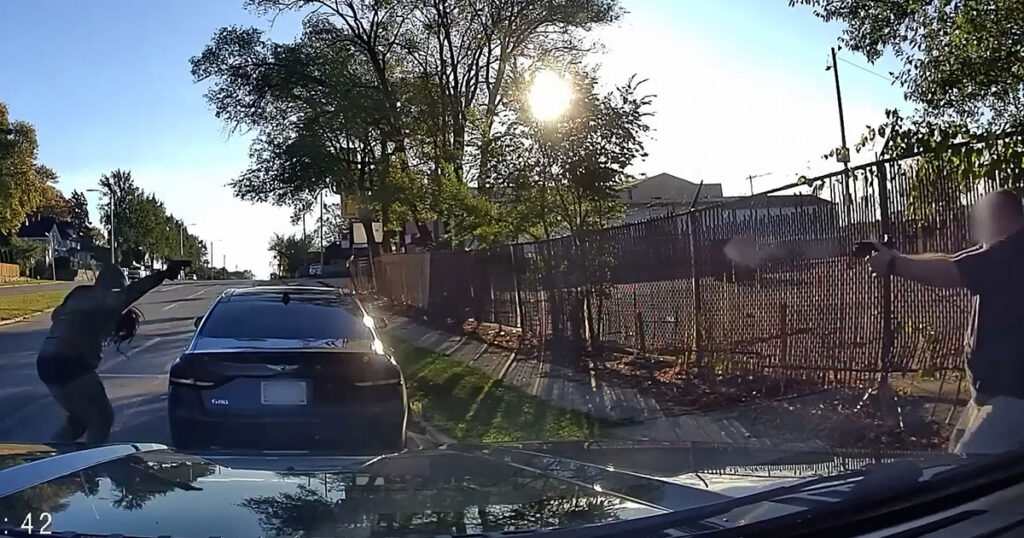MILWAUKEE, WI — An off-duty Milwaukee Police Department officer fatally shot a man who attacked him with a firearm following a minor traffic collision on the city’s northwest side last Thursday morning.
The incident occurred around 8:25 a.m. on October 9, 2025, in the 4800 block of West Mill Road. According to police, the 40-year-old officer, a 21-year veteran of the department, was driving to work when he was involved in a minor collision. Both drivers pulled over and exited their vehicles to assess the damage.
The situation escalated when the other driver, identified as 26-year-old Elijah Wilks, produced a firearm and struck the off-duty officer in the face with it. In response, the officer drew his department-issued firearm, and an exchange of gunfire followed. Wilks was struck and pronounced deceased at the scene. The officer was transported to a hospital for treatment of non-life-threatening injuries.
Dashcam footage from the officer’s vehicle captured the encounter and was released by the Milwaukee Police Department in accordance with its transparency policy, SOP 575. The video shows Wilks appearing to cut off the officer in a construction zone before the vehicles collided. After pulling over, the two exchanged words before Wilks produced a firearm and hit the officer. The video then shows Wilks pointing the gun at the officer prior to being shot.
As reported by Fox News, the family of Elijah Wilks, after viewing the footage, stated publicly that they believe the officer acted in self-defense. B’Ivory Lamarr, the family’s attorney, acknowledged during a press conference that the video shows Wilks striking the officer and pointing a gun at him, prompting the officer to fire his weapon.
“I don’t think I’ve ever come before and did a press conference like this, but we will acknowledge that we do believe that this officer-involved shooting was justified,” Lamarr said.
Though the family expressed concern over the officer not rendering aid after the shooting, they recognized that Wilks made a tragic and irreversible decision. “He made a decision that he should not have made, and that is just something we have to live with,” said Latrice Bell, Wilks’ aunt.
The officer has been placed on administrative duty, per standard protocol for officer-involved shootings. The Milwaukee Area Investigative Team is handling the investigation, led by the West Allis Police Department.
This incident highlights just how quickly a seemingly routine situation can escalate into a deadly encounter. The off-duty officer’s swift reaction—drawing and firing his firearm after being struck in the face with a gun—demonstrates the value of training, readiness, and situational awareness. It is very possible that the officer had already recognized signs of escalating danger, such as the suspect keeping a hand in his pocket or exhibiting other threatening behavior, which may have mentally prepared him to respond when the assault occurred.
For anyone who carries a firearm for self-defense, recognizing those pre-assault indicators is crucial. Training isn’t just about marksmanship—it’s about reading people, staying alert, and reacting decisively under pressure when the threat becomes imminent.
This case also reinforces the importance of video documentation. The dashcam footage played a critical role in supporting the facts of the case, even leading the suspect’s own family to conclude that the shooting was justified. Investing in a quality dashcam setup—like a front-and-rear camera system for around $120—can be one of the most cost-effective tools in protecting yourself legally after an incident. I recently installed one myself, and having that additional layer of evidence gives real peace of mind.
Finally, every armed citizen should be prepared for the legal aftermath of a defensive shooting. Even when your actions are justified, the legal process can be long, stressful, and expensive. That’s why it’s wise to have self-defense legal coverage through a reputable provider like CCW Safe. Having experienced attorneys and support behind you from the very beginning can make a critical difference in protecting your rights.
Preparedness doesn’t end when the threat is over—it extends through the legal and emotional challenges that may follow. Train well, stay alert, document what you can, and make sure you have a plan for the aftermath.
Read the full article here




